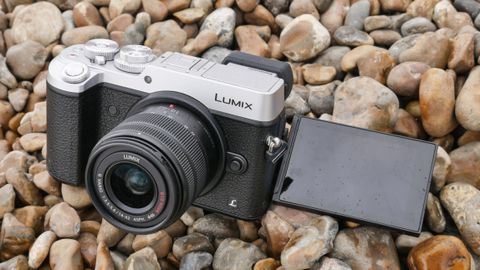Why you can trust TechRadar
Because it has an electronic viewfinder that's capable of previewing images with the settings applied, as well as reviewing shots, browsing through my shots from the GX8 doesn't bring any major surprises. On the whole the camera produces pleasant colours and good exposures.
As it's the first Micro Four Thirds camera to offer a pixel count of greater than 16 million, there's a lot of interest in how much detail the GX8 can capture, and how well noise is controlled – it's good news on both counts.
With the right lens the camera is capable of capturing an impressive level of detail. In our lab it matched the 24Mp Sony Alpha A6000 for detail at the lowest sensitivity setting, and its JPEGs beat it for much of the range. It also compares very well with the Olympus OM-D E-M5 II, although it doesn't have the same neat trick for increasing resolution.
The GX8 also impresses in the noise control stakes, with chroma noise only making the faintest of appearances in raw files shot at ISO 1600 when all noise reduction is turned off – you really have to look for it in images sized to 100%. Push up to ISO 3200 or 6400 and there's naturally an increase in the level of noise in raw files, but it's still subtle.

Click here to see the full-size image.

Click here to see the full-size image.
Meanwhile, JPEGs taken at the default settings look very good with lots of detail and a very slight smoothing of some details; at 100% raw files look a little more natural. Noise is more pronounced in raw files recorded at ISO 12,800, but there's also a good level of detail visible.
At ISO 25,600 there's a noticeable drop in saturation, and raw files are very noisy while JPEGs are soft, making them only suitable for use at relatively small sizes – but that's not unusual.
Panasonic has issued firmware upgrades for some of its lenses to enable them to work with the GX8's hybrid stabilization system. When shooting at the telephoto end of the Panasonic G X Vario 35-100mm f/2.8 lens, which with the Four Thirds type sensor has an effective focal length range of 70-200mm, I found that on a regular basis I was able to get images that look sharp at 100% using a shutter speed of 1/10 sec; even some shots taken at 1/8 sec were sharp.
Turning on the stabilization system also has a significant effect on the view in the viewfinder – it becomes much more stable, but there isn't the nauseating yaw that can occur with some older systems. It also has a positive impact upon video footage; you can't hand-hold the camera while walking and expect super-smooth movies, but the minor tremor and shake that we normally expect is gone.

Click here to see the full-size image.

Click here to see the full-size image.
Panasonic's general purpose Multi metering system has impressed me in the past, and this continues with the system in the GX8. There were a few occasions when I needed to use the exposure compensation dial during my time with the camera, but none of these were situations in which I wouldn't expect to. In many instances the camera manages to cope with quite large bright areas in the frame without dramatically underexposing the rest of the scene.
In some images the sky looks burned out, but it's possible to retrieve quite a bit of detail from the raw file to create a better-looking end result. It's not just the raw files that have good dynamic range though – the JPEGs are also decent.
With very high-contrast scenes the dynamic range enhancing system, iDynamic, is worth using to boost the tonal range of JPEGs. Even when this is set to its highest value it produces natural-looking, rather than overtly HDR, results.
The effect isn't always predictable, but it often has more noticeable effect on shadows than highlights, brightening the darker areas to bring out detail. Using it also often triggers the camera to set a lower exposure to capture more detail in the highlights, which means it has an impact upon raw files as well as JPEGs.

Click here to see the full-size image.
Using the automatic white balance setting and Standard Photo Style usually produces good results from the GX8, although if you want a little more warmth in overcast conditions it's worth switching to the Sunny setting. As is often the case, the Cloudy and Shade settings warm things a little too much.
The Standard Photo Style is a good all-rounder, but the other options – Vivid, Natural, Monochrome, Scenery and Portrait – are also worth exploring. Each can be adjusted to taste, and there's an option to save your own custom Photo Style.
Although I would usually convert raw files to mono in software, I found it was possible to produce some very nice in-camera black and white and toned images using the Monochrome setting.
There's also a collection of 22 filter effects that can be applied to JPEG files, with simultaneous raw files if you select the option. As usual these effects will appeal to some tastes and not others, but some can produce excellent results in the right situation, so it's worth experimenting with them. The Sun filter, for example, can add a colour cast along with a large white patch to simulate flare, and while it doesn't suit every scene there are times when it works very well.
Panasonic claims that its DFD (Depth from Defocus) autofocusing technology, first seen in the GH4, has a response time of 0.07 seconds in the GX8, and that there's a 200% improvement in AF tracking performance. I can't verify the figures, but I found the GX8 capable of keeping pace with moving subjects when the active AF point is held in the right place, and the tracking system can follow fairly fast-moving subjects.
I used the GX7 in the photographer's pit at Fairport Convention's Cropredy Festival 2013, and I was able to do the same with the GX8 this year. The newer camera's AF system was able to cope much better when light levels fell and the stage lights provided all the illumination, making the camera much more versatile than the previous model.

